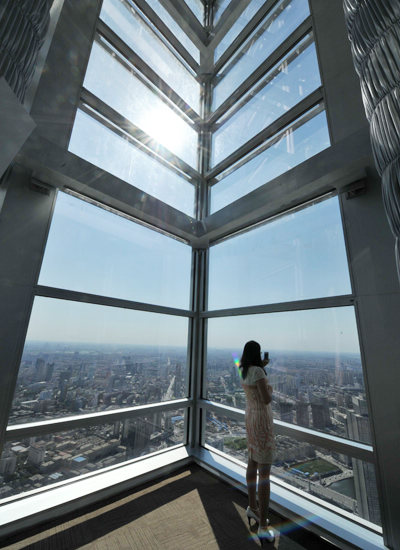|
 |
|
STRUCTURAL GLASS: The newly built Jinta Tower, the tallest building in Tianjin, features huge glass-clad walls (YUE YUEWEI) |
According to Xiang, for the sake of safety, glass curtain walls need to be checked every five years, and those over 15 years need a thorough safety check.
"But repair and maintenance are not cheap," said Yu Hui, a professor at the School of Architecture and Fine Arts of Dalian University of Technology. "For some glass panes high up in the sky, checking each square meter costs more than $100."
Zhou Hongjun, a professor at East China University of Political Science and Law, believes the construction of many buildings with glass curtain walls takes only the attractive exterior into account. "It overlooks the fact that cities in China have dense populations," he said.
According to Zhou, glass curtain walls are more than just a safety hazard, they cause light pollution and lead to excessive energy consumption because of the easy passage of heat.
The energy consumption of buildings with glass curtain walls is reportedly four times greater than that of ordinary buildings. People inside glass curtain walls often feel cold in winter and hot in summer, leading to increased use of air conditioners.
Glass curtain walls also act as huge mirrors that reflect sunshine and light. Medical researches suggest that excessive light exposure or the improper spectral composition of light may cause headaches, eye problems, work fatigue, stress, decreased sexual function and increased anxiety. In addition, glass walls can reflect traffic signals and produce illusions that can cause traffic accidents.
"Energy conservation and emissions reduction have become a widespread concern. It's time to limit the large-scale installation of glass curtain walls in new public buildings in China," said Liu Junyao, Deputy Director of the Shenzhen Institute of Building Research.
"Glass curtain walls, as external structures, have an average design life of 25 years. The service life of supporting parts, such as bolts and adhesives, is generally 10 to 15 years. They can become loose, rusty and unreliable," said Zhao Xi'an, a researcher with the China Academy of Building Research. "Some glass curtain walls overseas still work well after 50 or 60 years, thanks to timely checkups and maintenance. But there is no maintenance industry for glass curtain walls in China."
Following repeated accidents with casualties caused by glass curtain walls, some Chinese cities have worked out their own regulations on the issue.
The Construction and Administration Bureau of Xiamen in southeastern Fujian Province issued a notice on September 15, requiring all skyscraper owners to check glass curtain walls and submit a report before December 15 of this year.
According to a survey, there are over 2,000 glass curtain walls in Xiamen, of which more than 200 are more than 10 years old. The glass curtain walls of the city's first skyscrapers have been installed for more than 20 years. But the warranty period of the glue used to bond the glass curtain walls and metal structures is only 10 years.
On October 22, Shanghai issued a new draft regulation on glass curtain wall construction and management aimed at allaying safety concerns.
The draft regulation says glass curtain walls will be banned in newly-built apartments, hospitals, schools, kindergartens and rest homes. Restrictions will also be placed on the construction of such walls in scenic sites and places of historic and cultural significance. It also mandates safety inspections every four years.
Earlier, Shanghai authorities announced on July 29 that the city was going to conduct a thorough safety inspection of all the buildings with glass curtain walls and the work would be completed by the end of March 2012. The authorities also set the penalties from 10,000 yuan ($1,566) to 100,000 yuan ($15,660) to deter owners from skipping inspections.
"It is a bit late to set rigid restrictions, but not too late," said Lu. "We must be firm in the implementation of the new regulations."
Experts also called for more preventive measures, such as establishing or increasing green areas and other buffer zones around tall buildings, and requiring ceilings or awnings to be made of dual-pane glass or other stronger materials to protect pedestrians.
"In a bid to prevent similar 'glass rain' accidents, the government also needs to speed up the lawmaking process to regulate companies that work on glass curtain walls," Lu said. "An insurance system is highly recommended to help solve some of the current problems." | 